Promoting Consumer Adoption of Electric Vehicles from a Standard-Information-Behavior Perspective
Abstract
1. Introduction
2. Literature Review and Theory Backgrounds
2.1. Technical Standards and Innovation Diffusion/Adoption
2.2. Consumer Adoption of Electric Vehicles
2.3. Multi-Attribute Utility Theory (MAUT) et al.
2.4. Prospect Theory and Risk Aversion
- (1)
- What is the conceptional relationship between technical standards, quality attributes and consumer adoption behavior?
- (2)
- How can the multiple quality attributes be distinguished, and what are their relationships with standards and consumer adoption behavior?
- (3)
- How can the relationship between quality attributes and consumer adoption be quantitatively analyzed?
- (4)
- What are the implications for managers and policy makers for the electric vehicle industry?
3. Conceptional Relationship of Technical Standards and Consumer Adoption Behavior of Electric Vehicles
4. System Dynamics Model
4.1. SD Model of Consumer Adoption of Electric Vehicles
4.2. The Equations of the SD System
- (1)
- Mass media influence factor
- (2)
- Word-of-mouth network coefficient
- (3)
- Product information diffusion rate
- (4)
- Perceived risk
- (5)
- Perceived quality
- (6)
- Perceived network value
- (7)
- Adoption willingness
- (8)
- Adoption probability
- (9)
- Initial number of potential adopters
- (10)
- Product adoption change rate
- (11)
- Recommendation willingness
- (12)
- Others
5. Simulation of the SD Model
5.1. Parameter Initialization
5.2. Sensitivity Analysis of Probability of No Safety Issues Based on Safety Standards
5.3. Sensitivity Analysis of Probability of Complying with Performance Standards (Claimed Performance Advantages Based on Performance Standards)
5.4. Sensitivity Analysis of Compatibility with Existing and Future Charging Stations Based on Compatibility Standards (Complying with Compatibility Standards)
6. Conclusions
- (1)
- Quality attributes of EVs can be distinguished into intrinsic, measured, claimed and perceived quality attributes. Consumer trust is mainly based on the gap between claimed and actual attributes. Consumer adoption is based on perceived quality attributes based on experience and word-of-mouth. Therefore, manufacturers and policy makers will do best to represent the actual user scenario and deliver sufficient product quality information for promoting EV adoption in the long term.
- (2)
- Safety standards have a critical impact on innovation diffusion depth and speed. Safety standard market access probability is changed through technical barriers to trade, indirect effects of consumer trust, and consumer trust in safety standards and probability of complying with safety standards, which jointly affect consumers’ perceived risk. If safety standards are stringent, products encounter high barriers to access the market; however, if the requirement level is too low, consumers’ perceived risk is higher than that based on true data or actual accident history of electric vehicles. Thus, balance/trade-offs in safety standards between consumer needs, existing state-of-the-art technology, costs, risk assessment, etc. need to be taken into account for creating comprehensive and strategic policies.
- (3)
- Performance standards positively adjust the perceived quality, and improving product performance can accelerate diffusion speed and increase diffusion depth. Product performance improvement can increase consumers’ perceived quality and increase consumers’ recommendation willingness through word-of-mouth. Compared with traditionally fueled vehicles, electric vehicles have certain performance advantages and disadvantages, with range anxiety and charging time being key factors. If the performance standard threshold is increased, then consumers’ trust in performance standards and performance information is improved. On the contrary, if firms conceal relevant performance information through misleading test results, or disclose only partial performance data under the most-favorable conditions, they will lose consumer trust in the long term. Therefore, firms need to balance between technical investment and marketing claims to be competitive and win consumers’ trust for sustainable growth.
- (4)
- Compatibility standards and consumer trust in compatible installation bases such as charging facilities jointly affect the perceived network value, which positively affects adoption willingness and innovation diffusion. Due to inconsistency among different electric vehicle products, such as battery interfaces and parameters of charging devices, trust in compatibility impacts consumer adoption willingness and behavior. Consideration of compatibility standards and installation bases has a significant positive impact on innovation diffusion. It can greatly improve diffusion speed, and mutually compatible charging facilities can reduce unnecessary investment and waste of resources. Government and industry can take regulatory action to speed up the compatibility of vehicles and charging stations.
- (1)
- Based on innovation diffusion theory, TAM, Multi-Attribute Utility Theory (MAUT) and Prospect Theory, we distinguished between claimed quality attributes, intrinsic quality attributes, measured quality attributes and perceived quality attributes. We established a new Standard-Information-Behavior framework, then elaborated the conceptional relationships to explain perceived quality, perceived network value, perceived risk and consumer trust factors, to which we applied innovation diffusion theory to connect standard and consumer behavior. The factors of technical standards and consumer adoption were included in the model to explain EV production and consumption. This model can also be used as a reference for other industries and products.
- (2)
- We extended the adoption model to consider technical standards, consumer trust, product information, perceived risk, perceived quality and perceived network value, which are factors influencing adoption willingness. The adoption behavior influence mechanism due to the technical standards is clarified through the factors.
- (3)
- The intrinsic quality attributes are the inherent characteristic; the measured quality attributes are tested against the technical standards; the claimed quality attributes are based on manufacturer advertising; the perceived quality attributes are experienced quality characteristics, which are more related to intrinsic quality attributes.
- (4)
- A System Dynamics model with simulation was introduced to explain the heterogeneous effects of claimed different types of quality attributes based on technical standards on consumer adoption of EVs. The model is comprised of factors based on the conceptional mechanism based on the background theory. We explored quantitatively in detail how the different types of quality factors change consumer adoption behavior.
Author Contributions
Funding
Institutional Review Board Statement
Informed Consent Statement
Data Availability Statement
Conflicts of Interest
References
- Coffman, M.; Bernstein, P.; Wee, S. Electric vehicles revisited: A review of factors that affect adoption. Transp. Rev. 2017, 37, 79–93. [Google Scholar] [CrossRef]
- Bahrami, S.; Atkin, B.; Landin, A. Innovation diffusion through standardization: A study of building ventilation products. J. Eng. Technol. Manag. 2019, 54, 56–66. [Google Scholar] [CrossRef]
- Sartori, E.; Colapinto, C.; Tolotti, M. Awareness, persuasion, and adoption: Enriching the Bass model. Phys. A Stat. Mech. Its Appl. 2014, 395, 1–10. [Google Scholar] [CrossRef]
- Forrester, J.W. Industrial Dynamics; MIT Press: Cambridge, MA, USA, 1961. [Google Scholar]
- Blind, K. The economic functions of standards in the innovation process. In Handbook of Innovation and Standards; Edward Elgar Publishing: Cheltenham, UK, 2017; pp. 38–62. [Google Scholar]
- Egyedi, T.M.; Ortt, J.R. Towards a functional classification of standards for innovation research. In Handbook of Innovation and Standards; Edward Elgar Publishing: Cheltenham, UK, 2017; pp. 105–131. [Google Scholar]
- Blind, K. The Impact of Standardization and Standards on Innovation: Compendium of Evidence on Innovation Policy Intervention; Manchester Business School, University of Manchester: Manchester, UK, 2013. [Google Scholar]
- Jan, M. Domestic regulation, international standards, and technical barriers to trade. World Trade Rev. 2005, 4, 249–274. [Google Scholar] [CrossRef][Green Version]
- Tassey, G. The economic nature of knowledge embodied in standards for technology-based industries. In Routledge Handbook of the Economics of Knowledge; Routledge: London, UK, 2015; pp. 189–208. [Google Scholar]
- Rogers, E.M. The Diffusion of Innovations; Free Press: Glencoe, IL, USA, 1962. [Google Scholar]
- Bass, F.M. Comments on “A new product growth for model consumer durables the bass model”. Manag. Sci. 2004, 50 (Suppl. S12), 1833–1840. [Google Scholar] [CrossRef]
- Harrison, G.; Thiel, C. An exploratory policy analysis of electric vehicle sales competition and sensitivity to infrastructure in Europe. Technol. Forecast. Soc. Chang. 2017, 114, 165–178. [Google Scholar] [CrossRef]
- Han, L. Research on Consumer Value Perception and Purchase Behavior Intention of Private Electric Vehicles. Ph.D. Thesis, University of Science and Technology of China, Hefei, China, 2019. [Google Scholar]
- Xu, Y.; Li, L. Research on long-term diffusion of new energy vehicles considering customer perceived utility in competitive markets. Appl. Res. Comput. 2021, 5, 1482–1486. [Google Scholar] [CrossRef]
- Simsekoglu, O.; Nayum, A. Predictors of intention to buy a battery electric vehicle among conventional car drivers. Transp. Res. Part F Traffic Psychol. Behav. 2019, 60, 1–10. [Google Scholar] [CrossRef]
- Hsin, H.C.; Su, W.C. The Impact of Online Store Environment Cues on Purchase Intention Trust and Perceived Risk as a Mediator. Online Inf. Rev. 2008, 32, 818–841. [Google Scholar] [CrossRef]
- Kirmani, A.; Baumgartner, H. Reference points used in quality and value judgements. Mark. Lett. 2000, 11, 299–310. [Google Scholar] [CrossRef]
- Goerlandt, F.; Li, J.; Reniers, G. The Landscape of Risk Perception Research: A Scientometric Analysis. Sustainability 2021, 13, 13188. [Google Scholar] [CrossRef]
- Febransyah, A. Predicting Purchase Intention towards Battery Electric Vehicles: A Case of Indonesian Market. World Electr. Veh. J. 2021, 12, 240. [Google Scholar] [CrossRef]
- Sunddararaj, S.P.; Rangarajan, S.S.; Nallusamy, S.; Collins, E.R.; Senjyu, T. A Brief Survey on Important Interconnection Standards for Photovoltaic Systems and Electric Vehicles. World Electr. Veh. J. 2021, 12, 117. [Google Scholar] [CrossRef]
- Dwivedi, Y.K.; Rana, N.P.; Jeyaraj, A.; Clement, M.; Williams, M.D. Re-examining the Unified Theory of Acceptance and Use of Technology (UTAUT): Towards a Revised Theoretical Model. Inf. Syst. Front. 2019, 21, 719–734. [Google Scholar] [CrossRef]
- Davis, F.D.; Bagozzi, R.; Warshaw, P. User Acceptance of Computer Technology: A Comparison of Two Theoretical Models. Manag. Sci. 1989, 35, 982–1003. [Google Scholar] [CrossRef]
- Xia, M.; Deng, X. An Analysis of the Optimal Effect of Government in the Diffusion of Industrial General Purpose Technologies-Based on the Transformed Bass Model. J. Beijing Inst. Technol. Soc. Sci. Ed. 2019, 21, 78–86. [Google Scholar]
- Ma, Y.; Wang, Z.; Li, H.; Zhou, W. Network structure, adopters preference and Innovation diffusion: A simulation analysis of the S-D model of innovation diffusion based on the decision making process of adopters. Oper. Res. Manag. Sci. 2016, 25, 106–115. [Google Scholar] [CrossRef]
- Shi, H.; Liu, Y.; Petruzzi, N.C. Consumer heterogeneity, product quality, and distribution channels. Manag. Sci. 2013, 59, 1162–1176. [Google Scholar] [CrossRef]
- Kim, S.; Choi, J.; Yi, Y.; Kim, H. Analysis of Influencing Factors in Purchasing Electric Vehicles Using a Structural Equation Model: Focused on Suwon City. Sustainability 2022, 14, 4744. [Google Scholar] [CrossRef]
- Ferguson, M.R.; Mohamed, M.; Higgins, C.D.; Abotalebi, E.; Kanaroglou, P.S. How open are Canadian households to electric vehicles? A national latent class choice analysis with willingness-to-pay and metropolitan characterization. Transp. Res. Part D Transp. Environ. 2018, 58, 208–224. [Google Scholar] [CrossRef]
- Tversky, A.; Kahneman, D. Advances in prospect-theory-cumulative representation of uncertainty. J. Risk Uncertain. 1992, 5, 297–323. [Google Scholar] [CrossRef]
- Kahneman, D.; Tversky, A. Prospect Theory: An Analysis of Decision under Risk. Econom. J. Econom. Soc. 1979, 47, 263–291. [Google Scholar] [CrossRef]
- Hu, L.; Dong, J.; Lin, Z. Modeling charging behavior of battery electric vehicle drivers: A cumulative prospect theory based approach. Transp. Res. Part C Emerg. Technol. 2019, 102, 474–489. [Google Scholar] [CrossRef]
- Li, S.; Yao, Q.; Xu, Z.; Gao, J.; Yang, Y. Based on Prospect Theory Regional Integrated Energy Electric Vehicle Scheduling Model. In E3S Web of Conferences; EDP Sciences: Les Ulis, France, 2021; Volume 299. [Google Scholar] [CrossRef]
- Yu, Q.; Yu, Z.; Ma, D. A Multiplex Network Perspective of Innovation Diffusion: An Information-Behavior Framewor. IEEE Access 2020, 8, 36427–36440. [Google Scholar] [CrossRef]
- Hidrue Michael, K.; Parsons George, R.; Kempton, W.; Gardner Meryl, P. Willingness to pay for electric vehicles and their attributes. Resour. Energy Econ. 2011, 33, 686–705. [Google Scholar] [CrossRef]
- Chu, Y.; Zhu, T. Research on Forecast of Electric Vehicle’s Ownership in China Based on Bass Model and GM(1,1) Model. Math. Pract. Theory 2021, 51, 21–32. [Google Scholar]
- Zheng, R. Research on the Legal System and Improvement of Defective Automobile Product Recall System. Master’s Thesis, East China University of Science and Technology, Shanghai, China, 2021. [Google Scholar]
- Sun, X.; Sun, R.; Xu, S. The Network Effect of Electric Vehicles Industry: Identification and Heterogeneity Test. China Soft Sci. 2018, 4, 132–145. [Google Scholar]
- Wang, Z.; Ma, Y.; Zhang, F. Study on Technical Innovation Diffusion Model and Simulation Based on System Dynamics. Sci. Technol. Prog. Policy 2015, 32, 13–19. [Google Scholar] [CrossRef]
- Sun, W.; Zhang, Z. Promoting Electric Vehicle Cell Innovation Diffusion Considering Patent Licensing Strategy: A Combination of Evolutionary Game and Optimization Algorithm Approach. World Electr. Veh. J. 2021, 12, 95. [Google Scholar] [CrossRef]
- Sun, W.; Yuan, M.; Zhang, Z. The Evolutionary Game Analysis and Optimization Algorithm of Electric Vehicle Cell Innovation Diffusion Based on a Patent Pool Strategy. World Electr. Veh. J. 2021, 12, 251. [Google Scholar] [CrossRef]
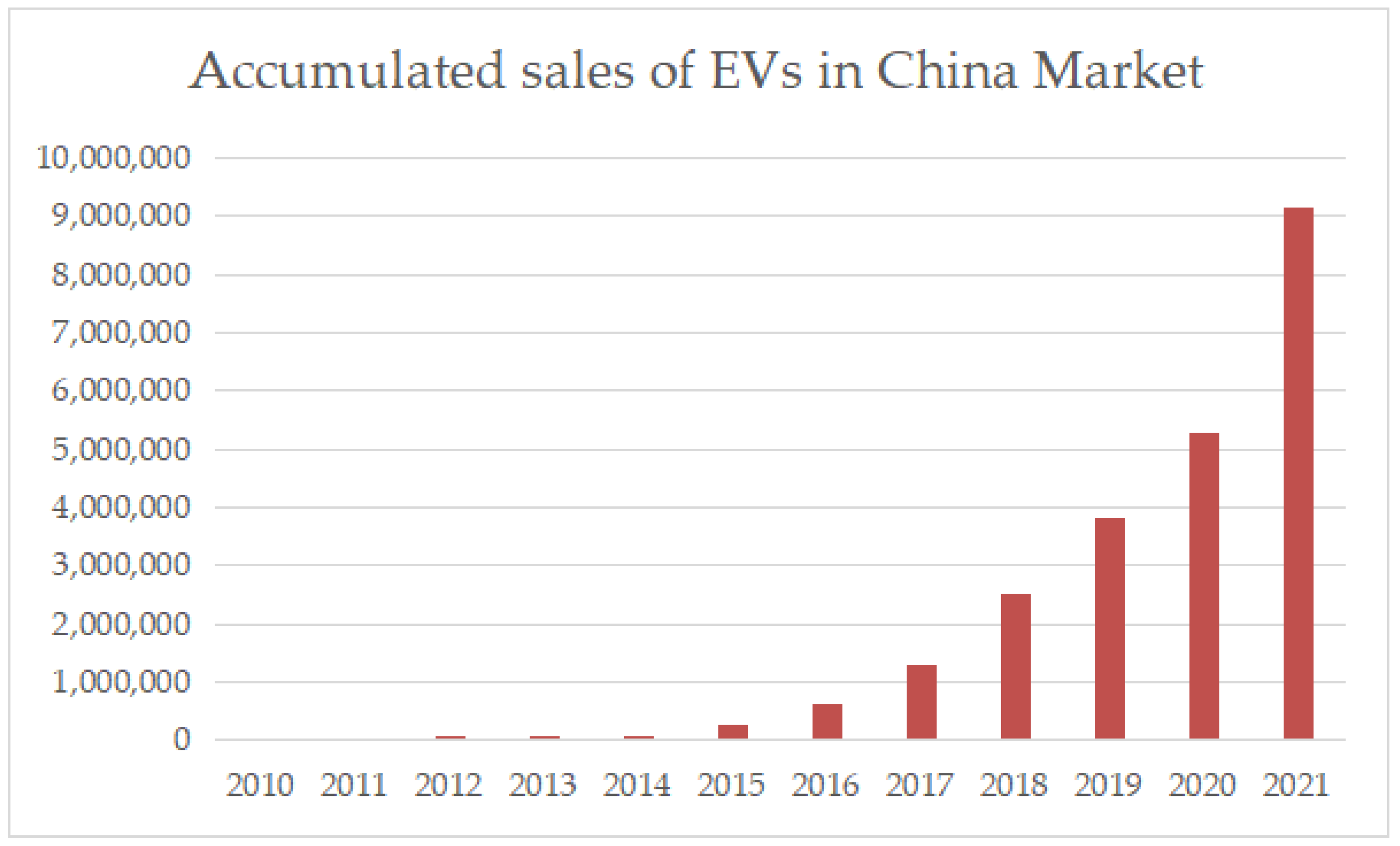
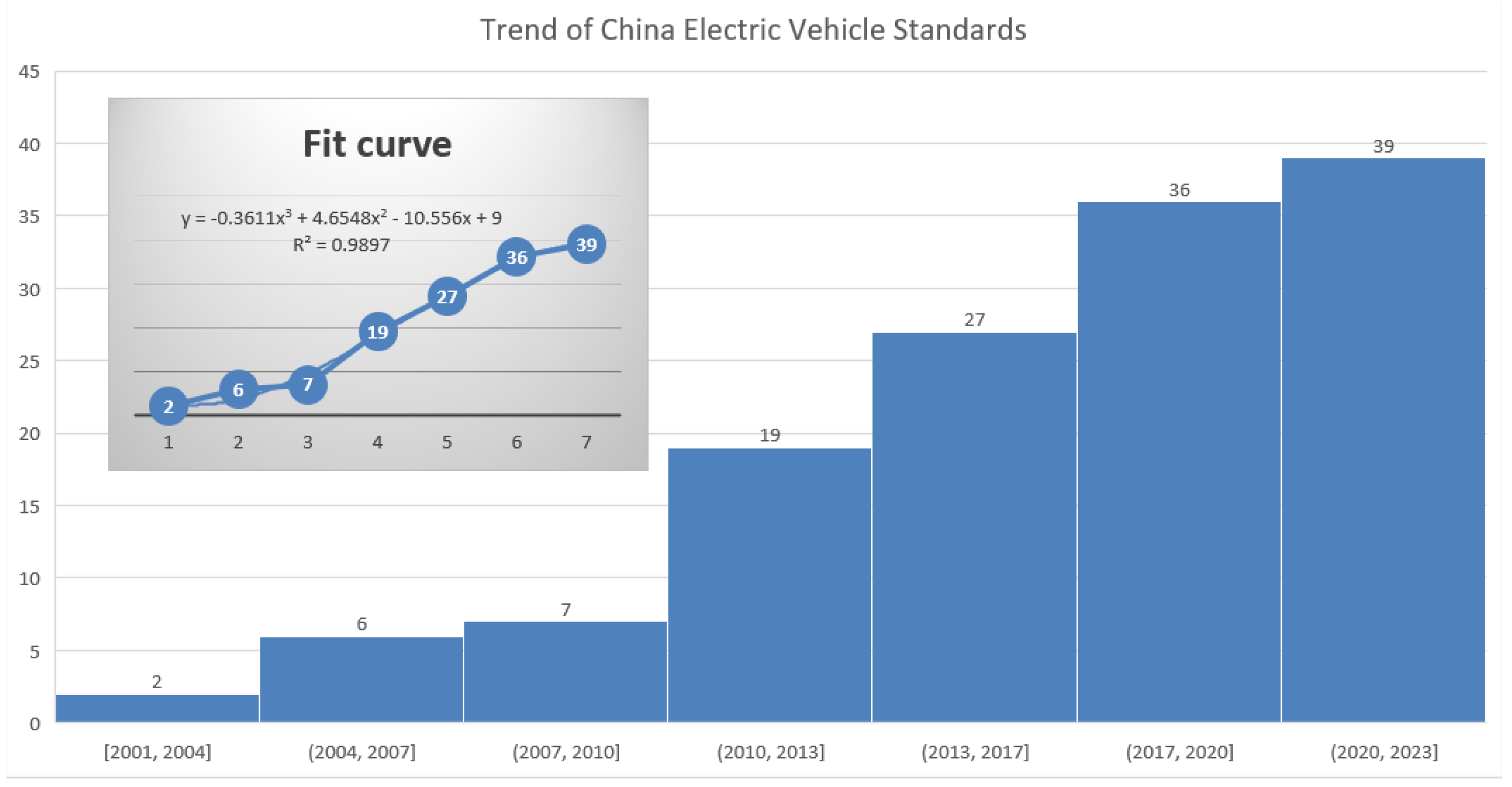
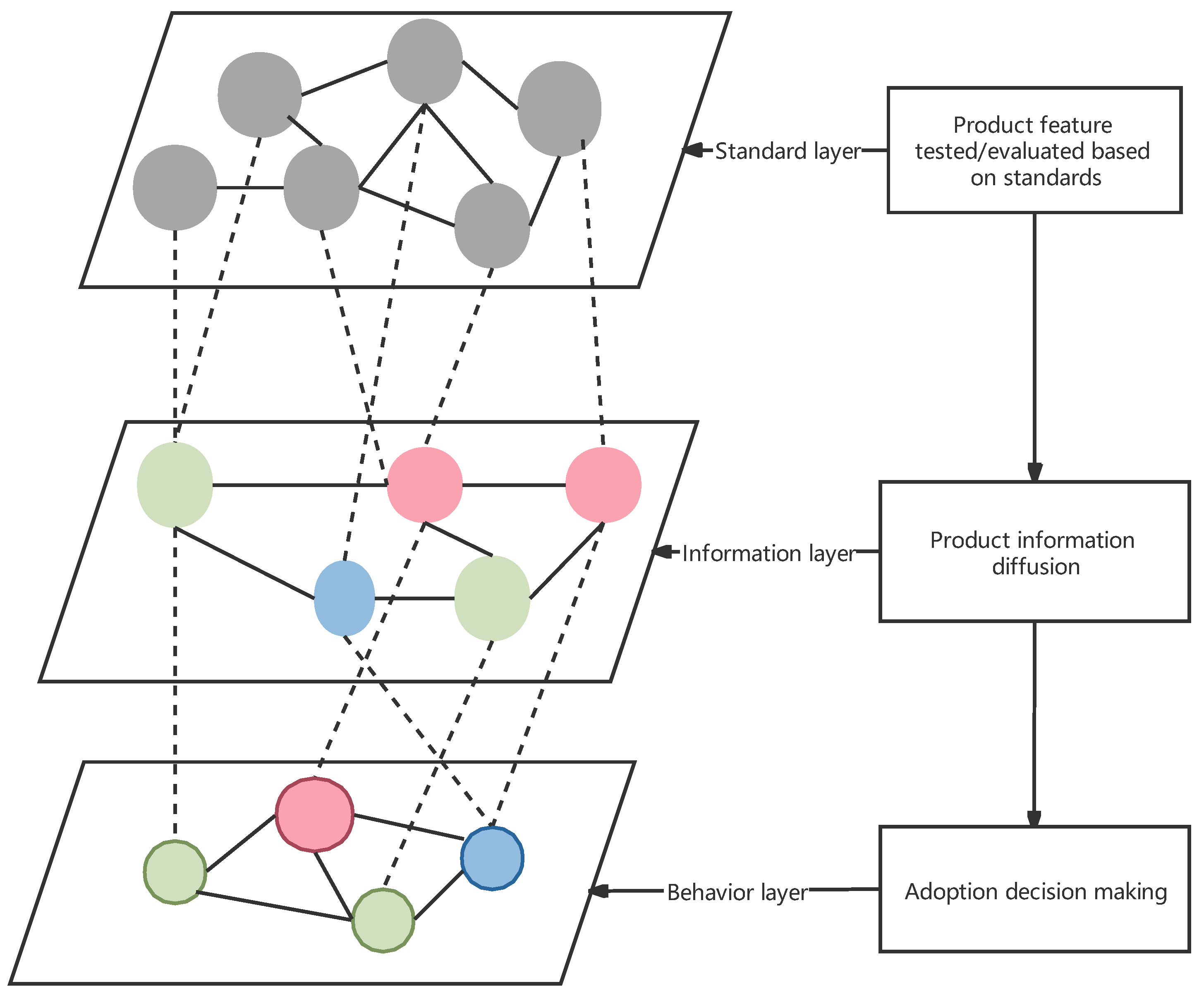
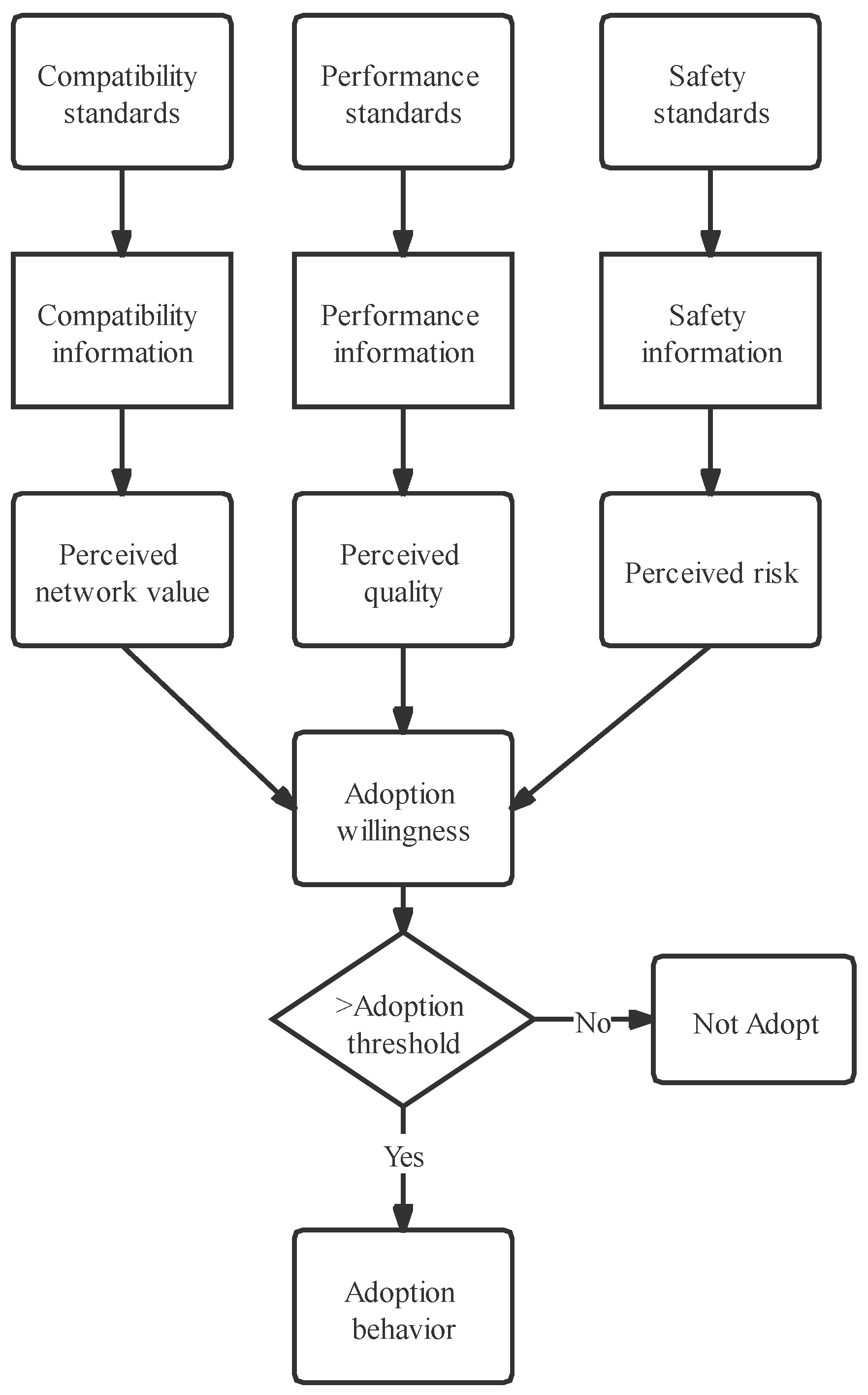
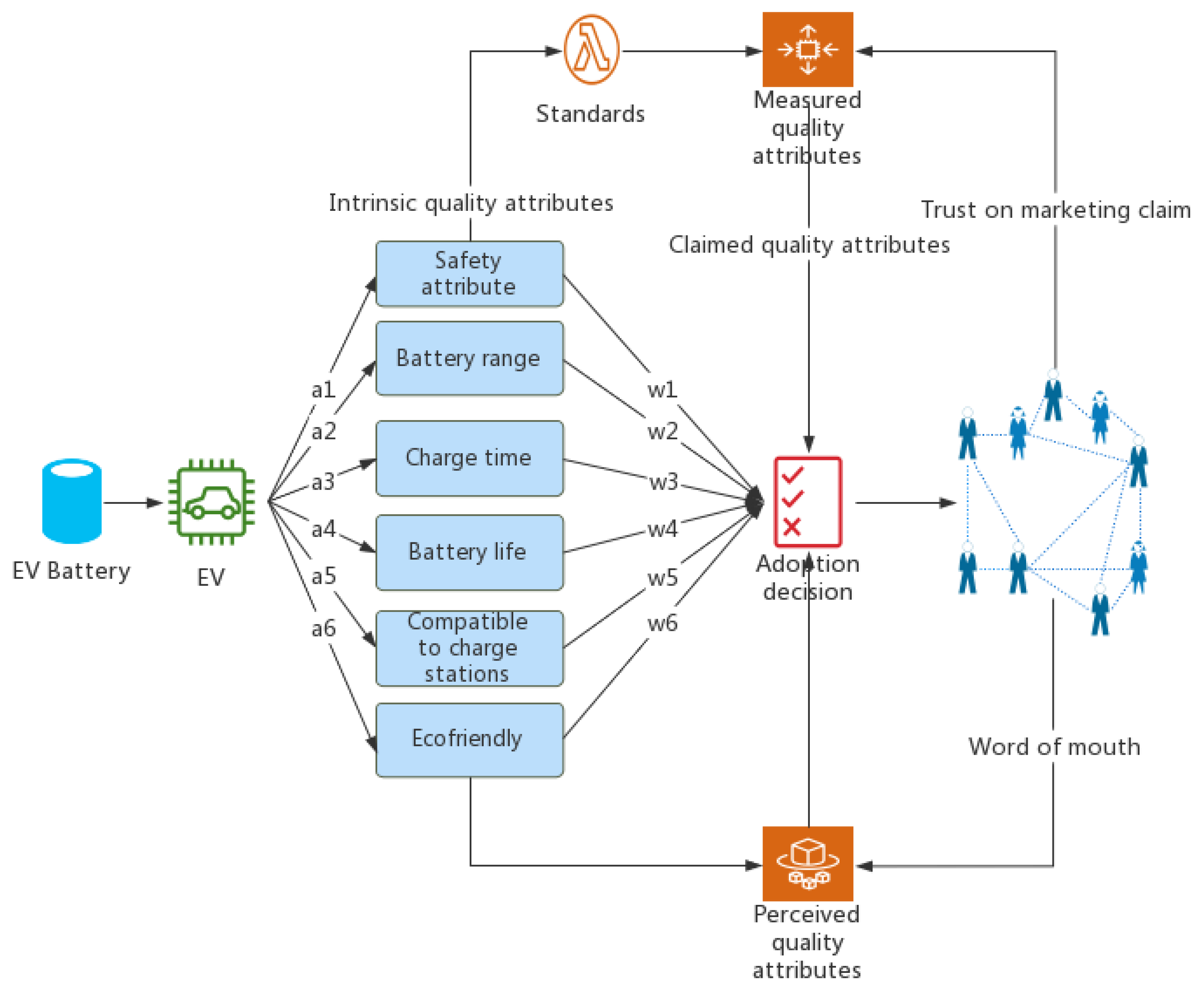
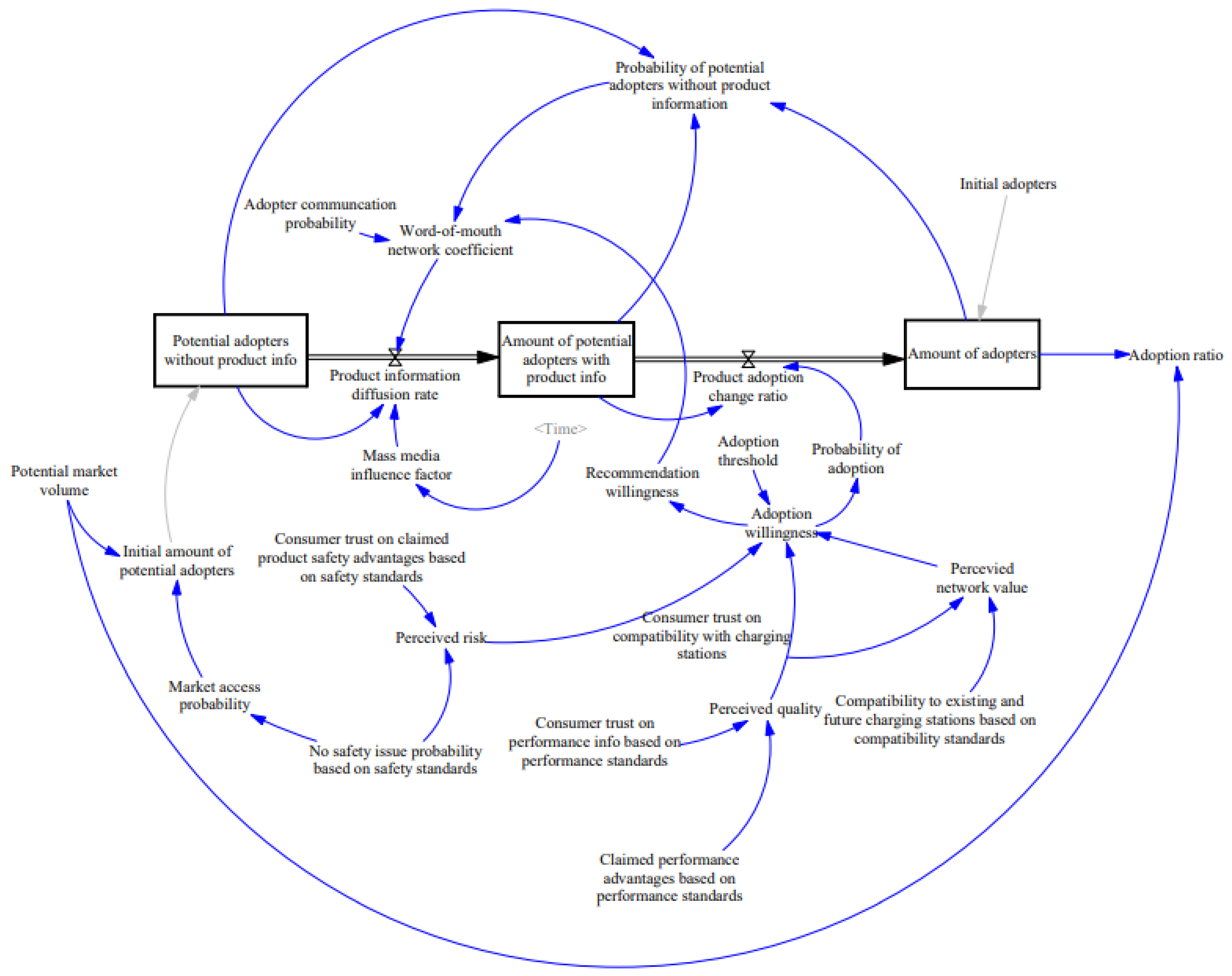
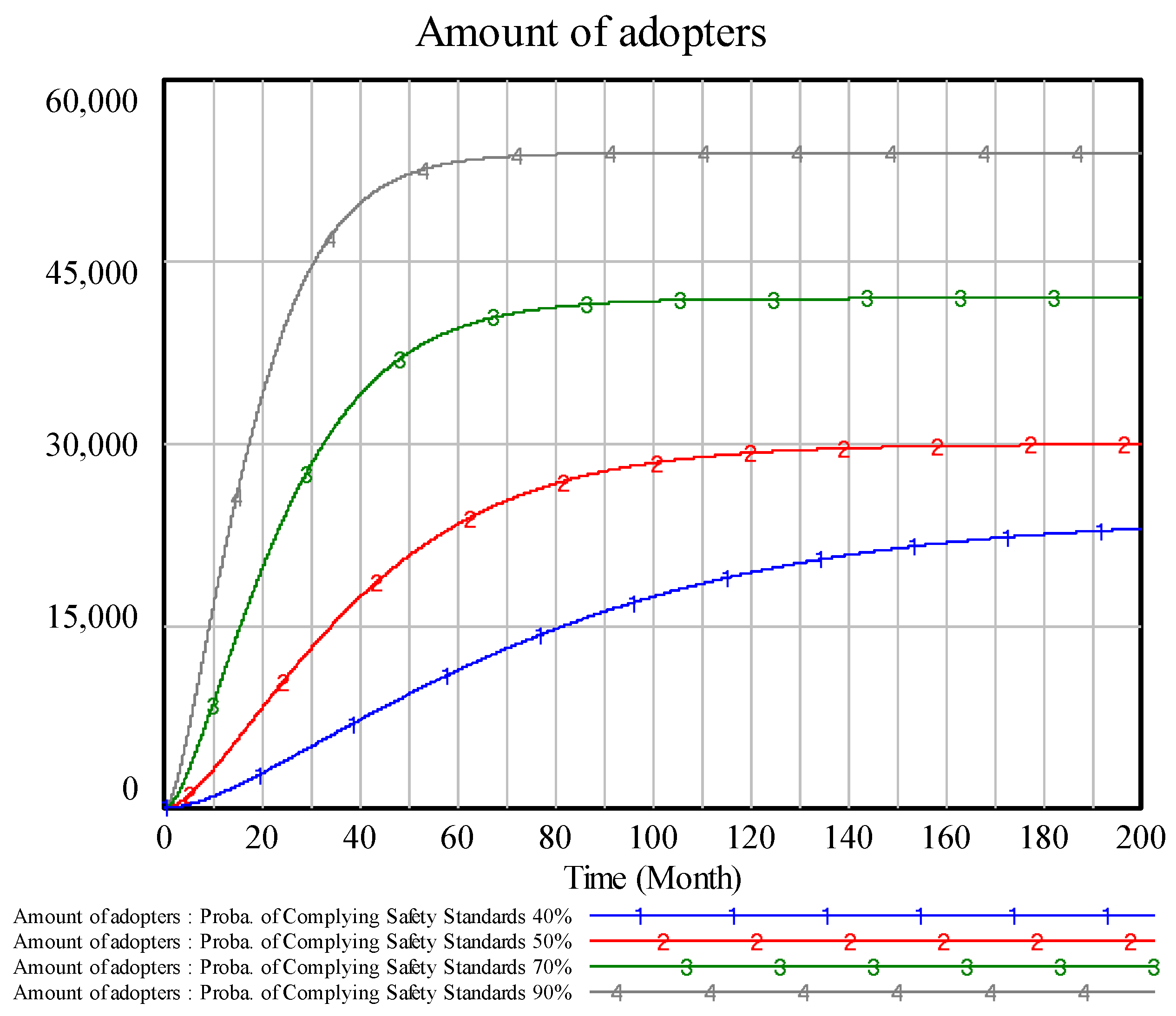

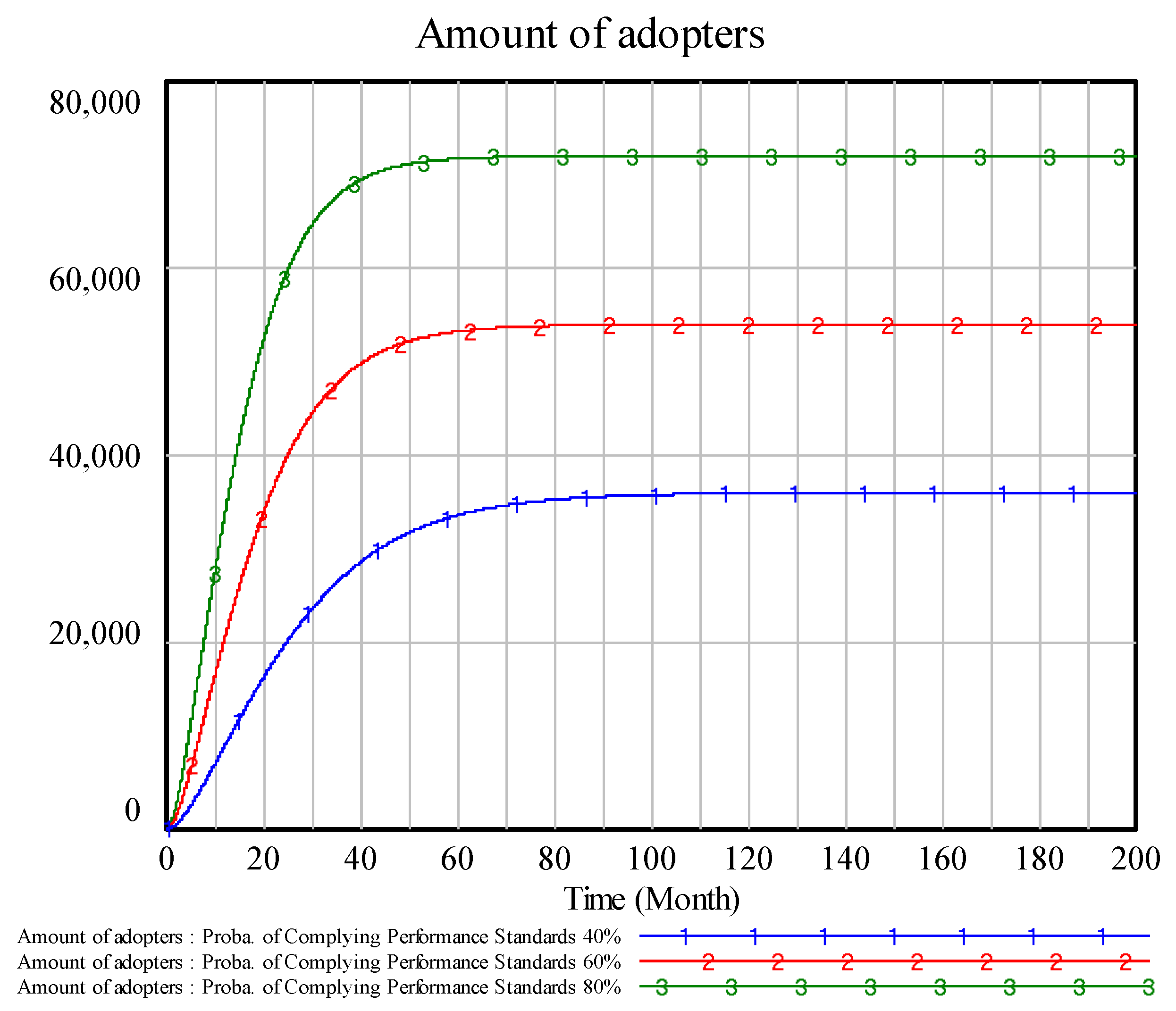
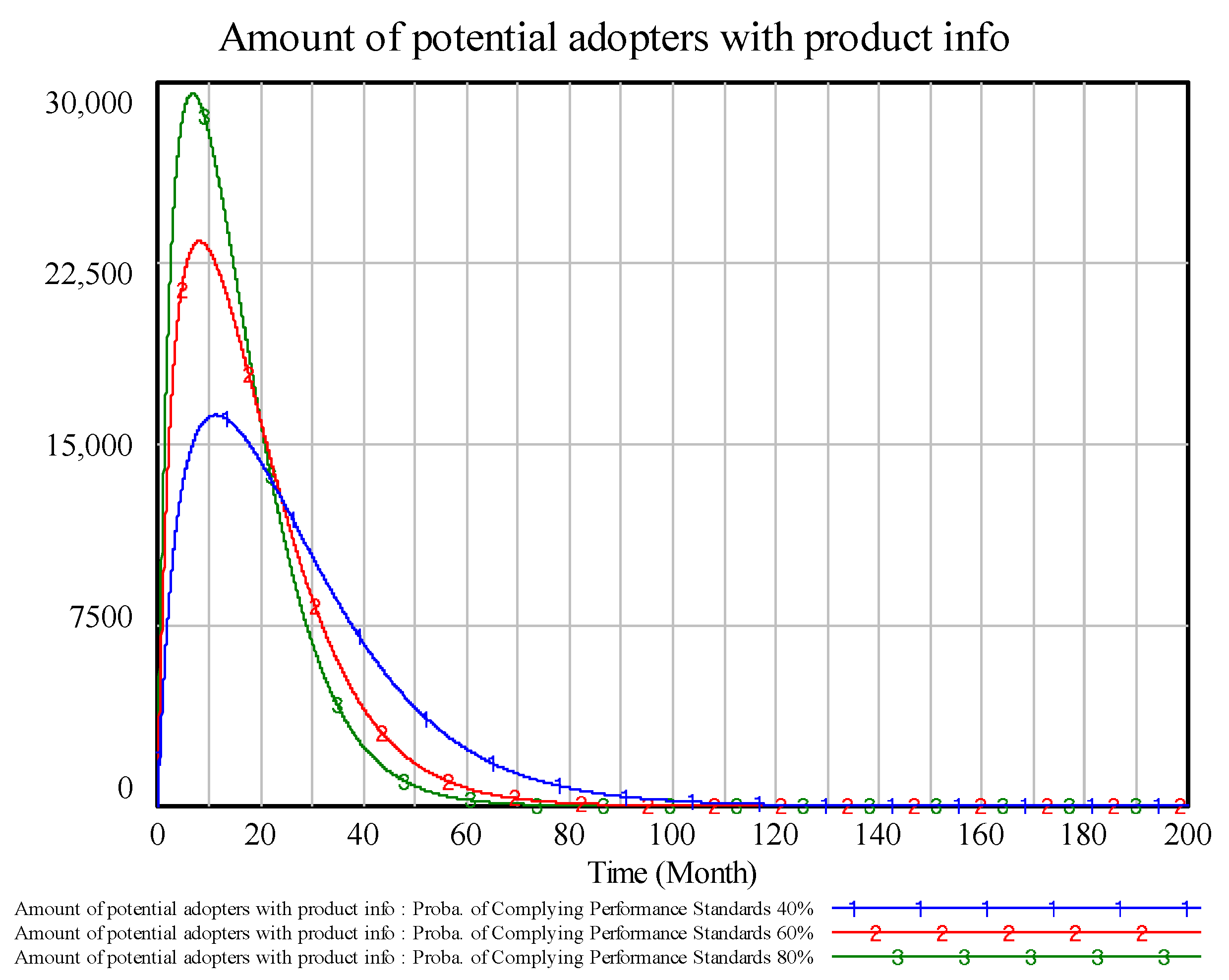
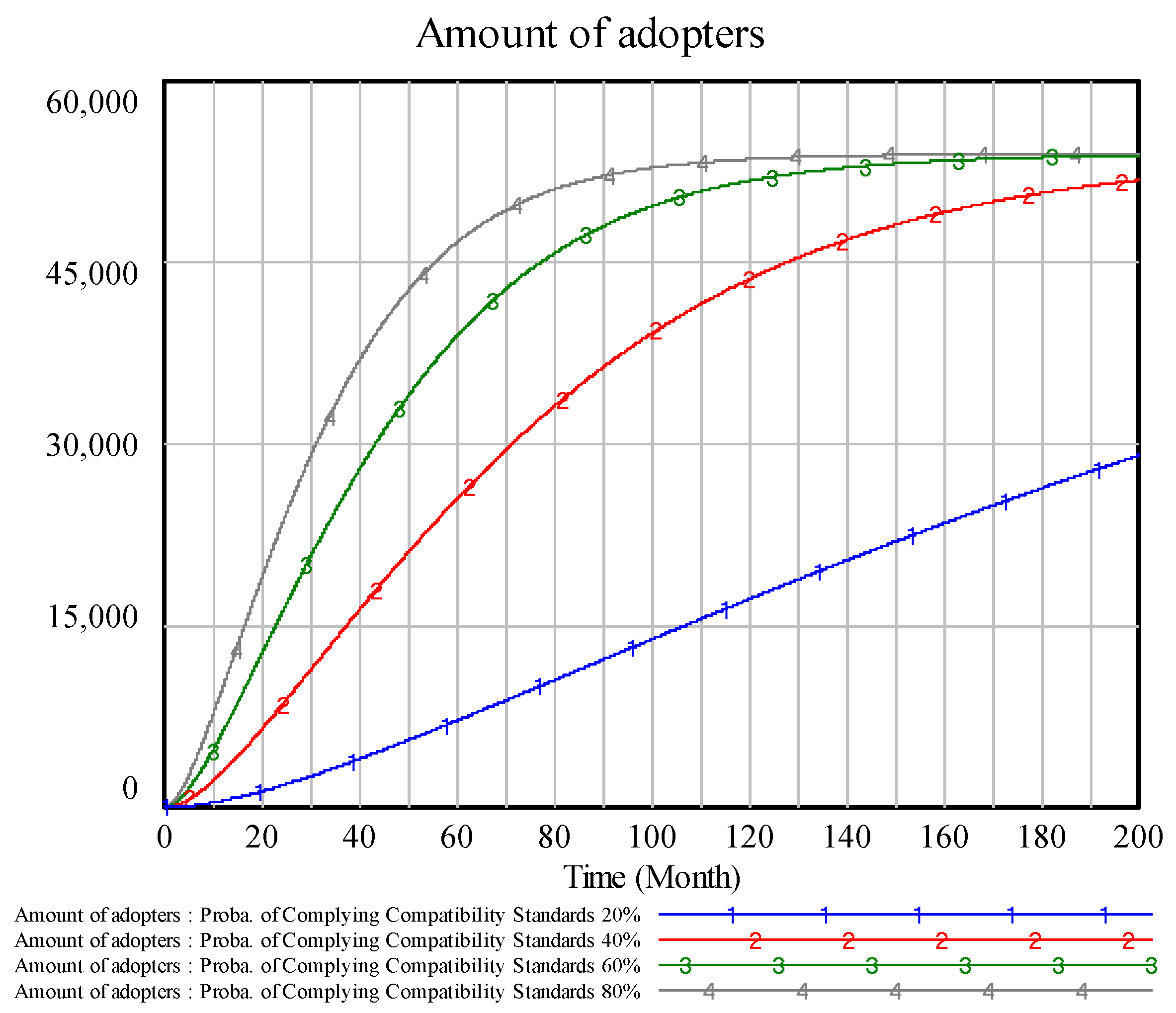

| Taxonomy of Technical Standards | Roles of Standards in Innovation Diffusion |
|---|---|
| Safety standards | Reducing transaction costs [7] Reducing uncertainty of the product [7] Avoiding/correcting adverse selection [7] Basis of technical barriers to trade [8] |
| Performance standards | Reducing transaction costs [9] Reducing uncertainty of the product [7] Avoiding/correcting adverse selection [7] |
| Compatibility standards | Accelerating market penetration [9] Generating network effects [5,7] Facilitating interchange and communication [5] |
| Parameter | Initial value | Unit | Justification |
|---|---|---|---|
| Potential market volume | 100,000 | Person | Based on average value of literature [34] |
| Consumer trust of claimed product safety advantages based on safety standards | 50 | % | Based on literature [35] |
| Consumer trust of performance info based on performance standards | 80 | % | Based on literature [35] |
| Consumer trust of compatibility with charging stations | 80 | % | Based on literature [36] |
| Probability of no safety issues based on safety standards | 80 | % | Based on literature [35] |
| Claimed performance advantages based on performance standards | 60 | % | Based on literature [35] |
| Compatibility with existing and future charging stations based on compatibility standards | 90 | % | Based on literature [36] |
| Adopter communication probability | 50 | % | Based on literature [37] |
| Adoption threshold | 1 | % | Based on literature [37] |
| Initial adopters | 0 | Person | Based on literature [37] |
Publisher’s Note: MDPI stays neutral with regard to jurisdictional claims in published maps and institutional affiliations. |
© 2022 by the authors. Licensee MDPI, Basel, Switzerland. This article is an open access article distributed under the terms and conditions of the Creative Commons Attribution (CC BY) license (https://creativecommons.org/licenses/by/4.0/).
Share and Cite
Sun, W.; Yuan, M.; Zhang, Z. Promoting Consumer Adoption of Electric Vehicles from a Standard-Information-Behavior Perspective. Information 2022, 13, 291. https://doi.org/10.3390/info13060291
Sun W, Yuan M, Zhang Z. Promoting Consumer Adoption of Electric Vehicles from a Standard-Information-Behavior Perspective. Information. 2022; 13(6):291. https://doi.org/10.3390/info13060291
Chicago/Turabian StyleSun, Weiwei, Min Yuan, and Zheng Zhang. 2022. "Promoting Consumer Adoption of Electric Vehicles from a Standard-Information-Behavior Perspective" Information 13, no. 6: 291. https://doi.org/10.3390/info13060291
APA StyleSun, W., Yuan, M., & Zhang, Z. (2022). Promoting Consumer Adoption of Electric Vehicles from a Standard-Information-Behavior Perspective. Information, 13(6), 291. https://doi.org/10.3390/info13060291






